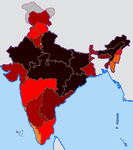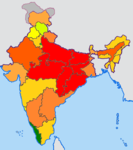List of Indian states and union territories by Human Development Index

This article lists the Human Development Index rating of the States and union territories of India. HDI is a composite index that takes into consideration health, education and income.
The national average HDI for India in 2008 was 0.467.[1] By 2010, its average HDI had risen to 0.519.[2][3] UNDP, the sponsor of the Human Development Index methodology since 1990, reported India's HDI to be 0.554 for 2012,[4] an 18% increase over its 2008 HDI. The United Nations declared India's HDI to be 0.586 in 2014,[5] a 5.77% increase over 2012. As for the year 2018, HDI for India stood at 0.647.[6][7][8]
List
This is a list of Indian states and union territories by Human Development Index as of 2019.[9]
| Rank | State/Union Territory | HDI (2019) |
|---|---|---|
| High human development | ||
| 1 | Kerala | 0.782 |
| 2 | Chandigarh | 0.776 |
| 3 | Goa | 0.763 |
| 4 | Lakshadweep | 0.751 |
| 5 | Delhi | 0.746 |
| 6 | Andaman and Nicobar Islands | 0.741 |
| 7 | Puducherry | 0.740 |
| 8 | Himachal Pradesh | 0.725 |
| 9 | Punjab | 0.724 |
| 10 | Sikkim | 0.717 |
| 11 | Tamil Nadu | 0.709 |
| 12 | Daman and Diu | 0.708 |
| 13 | Haryana | 0.708 |
| 14 | Mizoram | 0.704 |
| Medium human development | ||
| 15 | Maharashtra | 0.697 |
| 16 | Manipur | 0.697 |
| 17 | Jammu and Kashmir | 0.688 |
| 18 | Uttarakhand | 0.683 |
| 19 | Karnataka | 0.683 |
| 20 | Nagaland | 0.679 |
| 21 | Gujarat | 0.672 |
| 22 | Telangana | 0.669 |
| 23 | Dadra and Nagar Haveli | 0.663 |
| 24 | Arunachal Pradesh | 0.661 |
| 25 | Tripura | 0.658 |
| 26 | Meghalaya | 0.656 |
| 27 | Andhra Pradesh | 0.649 |
| – | 0.646 | |
| 28 | West Bengal | 0.641 |
| 29 | Rajasthan | 0.628 |
| 30 | Assam | 0.613 |
| 31 | Chhattisgarh | 0.611 |
| 32 | Odisha | 0.605 |
| 33 | Madhya Pradesh | 0.603 |
| 34 | Jharkhand | 0.598 |
| 35 | Uttar Pradesh | 0.594 |
| 36 | Bihar | 0.574 |
Trends by UNDP reports
Human Development Index (by UN Method) of Indian states since 1990 (2019 revision).[10]
| State | HDI | ||||||
|---|---|---|---|---|---|---|---|
| 1990 | 1995 | 2000 | 2005 | 2010 | 2015 | 2019 | |
| Northern India | |||||||
| Chandigarh | 0.627 | 0.636 | 0.633 | 0.660 | 0.648 | 0.732 | 0.776 |
| New Delhi | 0.577 | 0.619 | 0.663 | 0.690 | 0.709 | 0.728 | 0.746 |
| Haryana | 0.465 | 0.504 | 0.547 | 0.589 | 0.633 | 0.684 | 0.708 |
| Himachal Pradesh | 0.478 | 0.528 | 0.587 | 0.643 | 0.666 | 0.702 | 0.725 |
| Jammu and Kashmir | 0.493 | 0.510 | 0.526 | 0.586 | 0.640 | 0.672 | 0.688 |
| Madhya Pradesh | 0.403 | 0.429 | 0.455 | 0.497 | 0.535 | 0.581 | 0.603 |
| Punjab | 0.496 | 0.535 | 0.577 | 0.614 | 0.656 | 0.701 | 0.724 |
| Uttar Pradesh | 0.393 | 0.426 | 0.459 | 0.500 | 0.532 | 0.572 | 0.594 |
| Uttarakhand | 0.621 | 0.629 | 0.624 | 0.652 | 0.638 | 0.661 | 0.683 |
| Western India | |||||||
| Dadra and Nagar Haveli | 0.666 | 0.677 | 0.678 | 0.706 | 0.694 | 0.661 | 0.663 |
| Daman and Diu | 0.645 | 0.657 | 0.660 | 0.685 | 0.676 | 0.688 | 0.708 |
| Goa | 0.552 | 0.581 | 0.613 | 0.671 | 0.737 | 0.753 | 0.763 |
| Gujarat | 0.469 | 0.495 | 0.525 | 0.571 | 0.604 | 0.649 | 0.672 |
| Maharashtra | 0.493 | 0.524 | 0.556 | 0.601 | 0.644 | 0.678 | 0.697 |
| Rajasthan | 0.401 | 0.433 | 0.465 | 0.507 | 0.546 | 0.602 | 0.628 |
| Eastern India | |||||||
| Andaman and Nicobar Islands | 0.678 | 0.689 | 0.691 | 0.718 | 0.707 | 0.720 | 0.741 |
| West Bengal | 0.439 | 0.471 | 0.503 | 0.537 | 0.571 | 0.617 | 0.641 |
| Bihar | 0.376 | 0.404 | 0.433 | 0.467 | 0.512 | 0.554 | 0.574 |
| Chhattisgarh | 0.554 | 0.561 | 0.557 | 0.583 | 0.570 | 0.590 | 0.611 |
| Jharkhand | 0.554 | 0.562 | 0.558 | 0.584 | 0.571 | 0.580 | 0.598 |
| Odisha | 0.397 | 0.426 | 0.455 | 0.491 | 0.533 | 0.582 | 0.605 |
| Northeastern India | |||||||
| Assam | 0.408 | 0.444 | 0.485 | 0.528 | 0.564 | 0.595 | 0.613 |
| Arunachal Pradesh | 0.436 | 0.469 | 0.500 | 0.532 | 0.639 | 0.660 | 0.661 |
| Manipur | 0.494 | 0.525 | 0.557 | 0.596 | 0.681 | 0.692 | 0.697 |
| Meghalaya | 0.455 | 0.467 | 0.473 | 0.530 | 0.619 | 0.646 | 0.656 |
| Mizoram | 0.526 | 0.547 | 0.568 | 0.629 | 0.686 | 0.695 | 0.704 |
| Nagaland | 0.533 | 0.533 | 0.521 | 0.555 | 0.660 | 0.677 | 0.679 |
| Sikkim | 0.538 | 0.545 | 0.546 | 0.590 | 0.632 | 0.690 | 0.717 |
| Tripura | 0.444 | 0.486 | 0.529 | 0.559 | 0.607 | 0.641 | 0.658 |
| Southern India | |||||||
| Andhra Pradesh | 0.422 | 0.448 | 0.475 | 0.528 | 0.578 | 0.627 | 0.649 |
| Karnataka | 0.442 | 0.477 | 0.515 | 0.564 | 0.604 | 0.657 | 0.683 |
| Kerala | 0.545 | 0.569 | 0.598 | 0.679 | 0.716 | 0.757 | 0.782 |
| Lakshadweep | 0.687 | 0.699 | 0.700 | 0.728 | 0.716 | 0.730 | 0.751 |
| Puducherry | 0.713 | 0.724 | 0.725 | 0.754 | 0.742 | 0.729 | 0.740 |
| Tamil Nadu | 0.470 | 0.503 | 0.540 | 0.598 | 0.646 | 0.688 | 0.709 |
| Telangana | 0.616 | 0.624 | 0.622 | 0.648 | 0.636 | 0.649 | 0.669 |
| India | 0.429 | 0.461 | 0.494 | 0.536 | 0.579 | 0.624 | 0.646 |
Trend analysis by Indian National Development Reports
Compared with the previous Indian National Human Development Reports and the latest state-level government statistical report, India has significantly improved its HDI in all of its administrative subdivisions:
| Legend | ||||
|---|---|---|---|---|
|
Very High/High Human Development Index 0.850–0.899
0.800–0.849
0.750–0.799
0.700–0.749
|
Medium human development index 0.650–0.699
0.600–0.649
0.550–0.599
0.500–0.549
|
Low human development index 0.450–0.499
0.400–0.449
0.350–0.399
0.300–0.349
0.250–0.299
≤0.250
|
Lack of information
| |

This is a list of Indian states by their respective Human Development Index (HDI), as of 2008.[1] Kerala stands first in Human Development Index among the states in India.
- 1981 to 2011 Human development index in India
-
National Human Development Report 1981
(1981 data) -
National Human Development Report 1991
(1991 data) -
National Human Development Report 2001
(2001 data) -
National Human Development Report 2011
(2007–2008 data)
Consumption-based HDI
There are many ways to calculate HDI, and its calculation is sensitive to base data and assumptions. Using another approach, UNDP India and Government of India calculated the HDI nationwide average to be 0.605 in 2006.[12] This data was published by the Indian Government.[1] Note that the 2007-2008 HDI values in the table below is not based on income as is the UNDP standard practice for global comparisons, but on estimated consumption expenditure – an assumption which underestimates the HDI compared to the actual value.[13] Further, data was unavailable for the following union territories: Chandigarh, Lakshadweep, Andaman and Nicobar Islands, Daman and Diu, Puducherry, and Dadra and Nagar Haveli.[14][15]
| Rank | State/Union Territory | HDI |
|---|---|---|
| 1 | Kerala | 0.810 |
| 2 | Delhi | 0.750 |
| 3 | Himachal Pradesh | 0.652 |
| 4 | Goa | 0.617 |
| 5 | Punjab | 0.605 |
| 6 | Northeast India | 0.573 |
| 7 | Maharashtra | 0.572 |
| 8 | Tamil Nadu | 0.570 |
| 9 | Haryana | 0.552 |
| 10 | Jammu and Kashmir | 0.542 |
| 11 | Gujarat | 0.527 |
| 12 | Karnataka | 0.519 |
| – | National average | 0.513 |
| 13 | West Bengal | 0.492 |
| 14 | Uttarakhand | 0.490 |
| 15 | Andhra Pradesh | 0.473 |
| 17 | Rajasthan | 0.434 |
| 18 | Uttar Pradesh | 0.380 |
| 19 | Jharkhand | 0.376 |
| 20 | Madhya Pradesh | 0.375 |
| 21 | Bihar | 0.367 |
| 22 | Odisha | 0.362 |
| 23 | Chhattisgarh | 0.358 |
References
- ^ a b c "India Human Development Report 2011 (Towards Social Inclusion)" (PDF). IAMR, Planning Commission, Government of India. p. 257. Archived from the original (PDF) on 5 March 2016. Retrieved 5 April 2014.
- ^ "Selected Socio-Economic Statistics India, 2011" (PDF). Ministry of Statistics and Programme Implementation, Government of India. October 2011. Table 11.1, page 165. Archived from the original (PDF) on 3 March 2016. Retrieved 24 January 2015.
- ^ "India Human Development Report 2011 (Towards Social Inclusion)" (PDF). IAMR, Planning Commission, Government of India. p. 17. Archived from the original (PDF) on 5 March 2016. Retrieved 2 July 2014.
- ^ Human Development Report 2013 UNDP, page 64, Tabel 3.1
- ^ "Human Development Report 2014 – Sustaining Human Progress: Reducing Vulnerabilities and Building Resilience". United Nations Development Programme. January 2014. Retrieved 24 January 2016.
- ^ "India slips in human development index". The Hindu. 21 March 2017. Retrieved 14 September 2017.
- ^ "Sub-national HDI - Area Database - Global Data Lab". hdi.globaldatalab.org. Retrieved 24 October 2018.
- ^ "| Human Development Reports". hdr.undp.org. January 2018. Retrieved 16 February 2019.
- ^ "Human Development Indices (5.0)". Retrieved 27 August 2022.
- ^ "Human Development Indices (5.0)". Retrieved 27 August 2022.
- ^ "Gendering Human Development Indices" (PDF). Ministry of Women and Child Development, Government of India with UNDP India. March 2009.
- ^ Gendering Human Development Indices Archived 1 December 2014 at the Wayback Machine, Ministry of Women and Child Development, Govt of India with UNDP India (2009)
- ^ "India Human Development Report 2011 (Towards Social Inclusion)" (PDF). IAMR, Planning Commission, Government of India. p. 24. Archived from the original (PDF) on 5 March 2016. Retrieved 2 July 2014.
- ^ "Meghalaya Human Development Report 2008" (PDF). p. 23.
- ^ "General Reports: Planning Commission, Government of India". planningcommission.nic.in. Archived from the original on 4 March 2016. Retrieved 24 January 2016.
- ^ "India Human Development Report 2011 (Towards Social Inclusion) – Summary" (PDF). IAMR, Planning Commission, Government of India. p. 2. Retrieved 27 October 2014.





